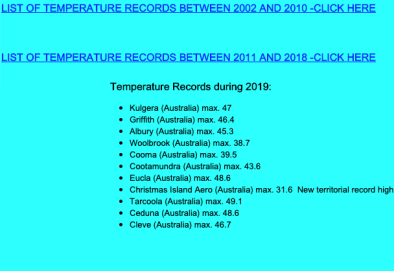European Heat Wave June 2019
Three days into summer, an extreme heat wave shattered all time high temperature records in western and central Europe. Eight European countries and hundreds of cities and municipalities experienced their highest recorded June temperature. In France, where vineyards were left scorched by heat, 13 weather stations broke the country’s all-time heat record of 111.4 degrees (44.1 Celsius) Friday, including three by at least one degree.
This early season heat wave is the latest in a number of historic episodes of heat in recent years. Last summer, the continent saw relentless record temperatures coupled with unusually dry conditions that caused extreme drought and wildfires.
Global warming has amplified the intensity, duration and frequency of extreme heat and heat waves. The hottest summers since 1500 AD in Europe were: 2018, 2010, 2003, 2016, 2002, and climate scientists have identified the fingerprint of climate change in many recent heat waves on the continent.
The immediate cause of the heat wave is a high pressure zone that has stalled over the region this week, resulting in a dome of sinking air and warming temperatures over Europe. Scientists have linked an increase in this kind of persistent weather pattern to climate change.
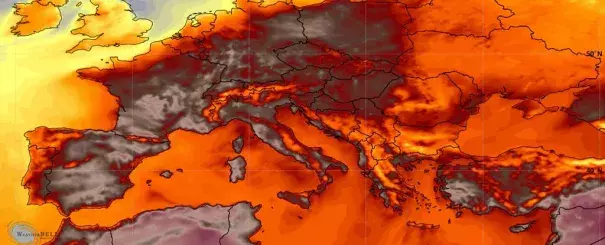
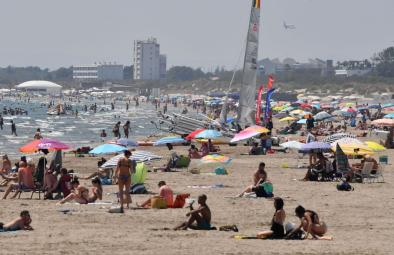


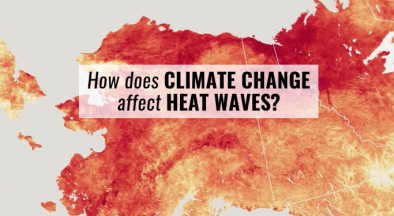

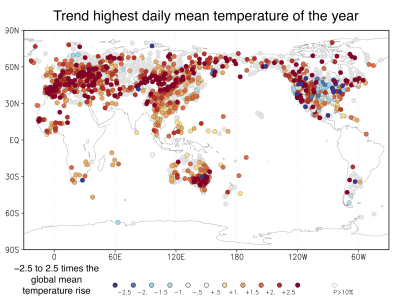
Climate science at a glance
- Rapid attribution analysis found that climate change made the record June 2019 heat in France up to 100 times more likely and up to 7.2°F (4°C) hotter.[1]
- Extreme heat and heat waves are some of the clearest impacts of climate change on extreme weather.
- Four out of five record-hot days globally are now amplified by global warming.[2]
- Hot nights are particularly characteristic of climate change on a warming planet.
- Hot nighttime temperatures reduce the number of critically important relief windows during heat waves.
- The hottest summers since 1500 AD in Europe were: 2018, 2010, 2003, 2016, 2002.[3]
- Attribution studies have found climate change had a direct hand in the severity of European heat waves during the following summers: 2018,[4] 2017,[5][6] 2015,[7][8] 2010,[9] and 2003.[10]
Climate signals breakdown
Climate signal #1: Extreme heat and heat waves
Record-breaking temperatures are a classic signal of climate change. As the average global temperature rises and the climate shifts, hot temperatures that were extreme under the old climate are closer to the middle of the new temperature range.[11]
Many urban areas across the globe have witnessed a significant increase in the number of heat waves, with the largest number of heat waves occurring in the most recent decade studied, 2003-2012.[12] In Europe, the five hottest summers since 1500 AD have all occurred since 2000 and include the years 2018, 2010, 2003, 2016, 2002.[3]
The World Weather Attribution group published a rapid attribution analysis focused on France and found that climate change made the record June 2019 heat in that country up to 100 times more likely.[1] The researchers also found that human-caused warming made the heatwave about 7.2°F (4°C) hotter than it would otherwise have been.[13][1] [13]
Climate change detection and attribution have found that climate change had a direct hand in European heat waves during the summers of 2018,[4] 2017,[5][6] 2015,[7][8] 2010,[9] and 2003.[10]
Observations consistent with climate signal #1
- Eight European countries experienced their highest recorded June temperature, including the Czech Republic, France, Germany, Luxembourg, Poland, the Principality of Andorra, Lichtenstein and Switzerland.[14]
- Germany's three oldest weather stations with reliable long-term data going back as far as 1824 broke their all-time high records for any month.[21] All time highs generally occur during July, the hottest summer month.
- In France, 13 weather stations broke the country’s all-time heat record of 111.4°F (44.1°C) Friday, including three by at least one degree.[14]
- The temperature at Montpellier-Fréjorgues airport hit 43.5°C (110.3° F) on June 28, 2019, breaking the station’s previous record by a truly incredible 5.8° C (10.4° F). The station’s period of record extends back 74 years, to 1946.[15]
Climate signal #2: Humidity and heat stress increase
As air warms, its capacity to hold water vapor increases, and measurements show that atmospheric humidity is increasing around the globe, consistent with a warming climate.[16] The Northern Hemisphere has had increasingly warmer and more humid summers, and the global area covered by extreme water vapor is increasing significantly.[17]
Exposure to extreme heat is already a significant public health problem and the primary cause of weather-related mortality. A 2016 study finds there has been a detectable human-caused increase in mean summertime heat stress since 1973, both globally and in most land regions analyzed.[18]
Observations consistent with climate signal #2
- As of July 1, at least 10 people are confirmed dead from the heat, with the toll expected to rise.[14]
- The warm air has been linked to the deaths of three swimmers at beaches in France related to “thermic shock” resulting from the temperature difference between the hot air and cool water.[19]
Climate signal #3: Atmospheric blocking increase
In addition to shifting the distribution of local temperatures, global warming is also altering the pattern of atmospheric circulation (e.g. the jet stream). And some of these global changes are dramatically amplifying local heat extremes. Waves in the jet stream are stalling in place (as opposed to moving eastward), leading to persistent weather patterns. This kind of weather pattern is often referred to as a “blocking” pattern because it slows the flow of weather systems circulating around the Northern Hemisphere.
A high-pressure zone over Greenland set the stage for the persistent, extreme heat in Europe during June 2019. When present, this kind of persistent weather extreme can affect the same areas for extended periods and fuel the intensity and duration of heat waves.
Observations consistent with climate signal #3
Related Content





